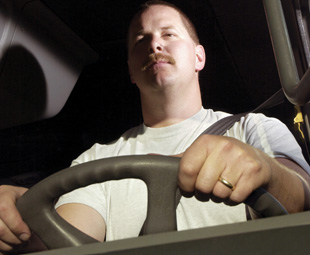Deadly dreaming

Driving without sufficient sleep is in many cases as dangerous as driving intoxicated. GAVIN MYERS investigates the risks.
Here’s something you may not have known: you can sleep while being awake. Well, more accurately, you can fall asleep, for anything from a few milliseconds to a few seconds, without even realising it. It’s called a microsleep, and it’s what happens when a person severely pushes their body past the point of tiredness and drowsiness – the body’s last “stop” before sleep.
In the case of a driver, drowsy behind the wheel, it’s at this point that an accident usually occurs.
And, according to Awake, a fatigue management consultancy in the United Kingdom (UK), these crashes are usually three times more likely to result in serious injury or death compared to other types of motor vehicle accidents, as the driver takes no evasive action prior to impact. Driver tiredness, in the UK at least, is also said to be the cause of 20 percent of crashes. Put another way in a 2013 study published in the Journal of Sleep Research, 44 percent of drivers become dangerously sleepy during late-night driving.
There are mountains and mountains of statistics on the subject.
Indeed, it has been widely publicised that being tired can impair one’s driving ability (in fact, any ability) as much as alcohol can. No respectful, professional transport operation would allow its drivers to get behind the wheel of a vehicle while inebriated. So why would it be expected of them to do so with a lack of sufficient sleep?
The reality is that, for a variety of reasons, drivers are regularly required to do so. Sometimes it is indeed due to tough schedules – drivers having to run loads from Johannesburg to Durban and then back again in the same day, for example. At other times it’s due to the lack of security at rest stops, the fear of falling victim to crime often forcing drivers to continue their journeys with minimal rest breaks (see our feature on truckers and crime in the November 2013 edition of FOCUS).
A study (the results of which were published in the South African Journal of Science) in which 102 long-haul truck drivers across South Africa were interviewed, found that 75 percent of truck drivers reported being tired on the job due to long working hours. At the time they were working approximately 93 hours a week and half of them got in less than five hours of sleep per day.
The issue of tired truck drivers is not a new or local one, either. It’s a global problem.
The American National Sleep Foundation reports that commercial truck drivers are especially susceptible to drowsy driving. It quotes a study, by the Federal Motor Carrier Safety Administration, of 80 long-haul truck drivers in the United States and Canada, which found that drivers averaged less than five hours of sleep per day. It states that for each truck driver fatality, another three to four people are killed. A study entitled The Sleep of Long-haul Truck Drivers, published in the U.S. National Institute of Health’s National Library of Medicine, concludes that long-haul truck drivers obtained less sleep than is required for alertness on the job.
It’s clear that the situation is not ideal, but why exactly is driving with a lack of sleep so dangerous? Tiredness affects a range of cognitive abilities which, in normal circumstances, can be handled without too much danger. But if we are involved in safety-critical work (of which driving forms a part) or are involved in an emergency situation, tiredness can be dangerous.
Awake notes that well-learned automatic responses are not generally affected, but our ability to understand complex situations; ignore irrelevant information; assess risks and anticipate the range of consequences; deal with surprise and the unexpected; keep track of changing events; develop and update strategies; communicate effectively and think laterally and innovatively, all are.
The National Sleep Foundation reinforces this, stating: “Studies have linked sleepiness and fatigue to decreases in vigilance, reaction time, memory, psychomotor coordination, information processing and decision making.”
Indeed a further study conducted by Manchester Metropolitan University, using a driving simulator and high-tech hand-eye trackers, found that sleep deprivation adversely affected the test subjects’ ability to coordinate eye movements and steering.
Of course, all of these skills are needed for safe driving – so how can drivers recognise the danger signs that their own bodies are showing?
According to the National Sleep Foundation, a person is too drowsy to drive safely if they have trouble keeping their eyes focused, can’t stop yawning and can’t remember driving the last few kilometres. In addition, frequent blinking, longer duration blinks and head nodding; daydreaming; and drifting from lane to lane or off the road are also serious indicators that the time to stop driving and rest has passed.
Unfortunately, as there is no breathalyser-type test for tiredness, the onus is on the driver (and co-driver if present) to drive responsibly. Likewise, just as operators should take the responsibility of ensuring their fleet is in a roadworthy condition, so too should they ensure their drivers are “fit for duty”. One way this could be done is to set a maximum number of hours they may drive per week.
Studies show that a quick 20-minute nap and a caffeinated beverage can boost a driver’s alertness for a short period, but is not a substitute for sleep and cannot overcome acute drowsiness. Eventually, that microsleep will kick in, at which point the vehicle is more likely to come to a stop only on impact.
Facts about sleep
• Most adults need between seven and eight hours of sleep a night, but this can vary by up to two hours.
• When a person does not get the amount of sleep they need, they build up “sleep debt”. People with “sleep debt” tend to feel very sleepy by the afternoon.
• Long-term sleep deprivation can: quadruple the risk of stroke; increase the risk of obesity, diabetes, heart disease and some cancers; lead to mood disorders; lower sperm-count; and increase mortality risk.
• Sleep quality is poorer when one has to sleep during daylight hours due to the body’s natural biological rhythm which causes it to want to sleep during the night.
• Between midnight and 04:00 (and, to a lesser extent, between 14:00 and 16:00) the body has a greater need for sleep. At these times of day, there is a natural tendency to sleep. You are at your most tired during the pre-dawn period, between 04:00 and 06:00.
Published by
Focus on Transport
focusmagsa




